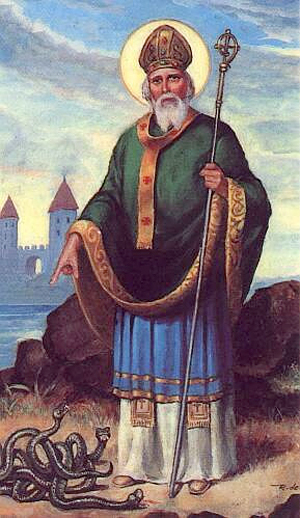 |
| "Snakes...why did it have to be snakes?" Though legend tells of St. Patrick driving serpents out of Ireland, he likely never encountered one of the legless beasts on the Emerald Isle. |
Saint Valentine’s Day once marked martyrdom, but I celebrated with Batman valentines. And maybe Easter rabbits really did come from ancient pagan customs, but I don’t think the Romans had Cadbury Crème eggs. All Hallows Eve now means candy, candy, candy. And as for eggnog, trick-or-treating and Mardi Gras (read: pancake Tuesday) – let’s not go there. Whatever ecclesiastical significance holidays once held, the twentieth century has an inarguable gift for getting down to something everything can agree on: fun and food. Now March 17 has arrived again, and St. Patrick’s Day once more gives study-weary students new excuses to make merry. It’s comforting to know that, in this case, that was always kind of the point.
“(St. Patrick’s Day) was associated with un-Lent-like behaviour,” says Cynthia Neville of the Department of History. Dr. Neville currently teaches the course “Celtic Britain and Ireland to 1200.” Medieval Europe is her speciality. “Irrespective of where Easter fell… (St. Patrick’s) always fell somewhere in Lent.” Partly, this was coincidence. St. Patrick’s Day, like most saint days, is celebrated not upon St. Patrick’s birth, but his death – after which Christian tradition says St. Patrick attained a better life in heaven. St. Patrick’s death in March set his feast day square in the middle of the holy Lenten fast, to the delight of parishioners. St. Patrick was so popular, with the common people and church authorities alike, that the powers that be would briefly lift the Lenten ban on meat, beer, and merrymaking.
“In Ireland, St. Patrick’s Day has always been the most important,” affirms Dr. Neville. “He was the most beloved Saint.” That love of St. Patrick’s goes way back: Dr. Neville suggests the holiday has been celebrated in excess of a thousand years. (Presumably, it was pretty consistently celebrated with excess, too.)
So who was St. Patrick? Besides the timing, why the consistent adulation when so many other “Saint’s Days” have fallen out of the general consciousness? (For instance, Wikipedia tells me that March 18 is the feast day of Saint Cyril. Maybe you knew this, but I didn’t.) Dr. Neville says St. Patrick is one of three Irish patron saints -- the others are Brigid and Columba. Patrick’s legacy is mired in mythology, but some facts can still be gleaned. “We think he was active in Ireland as a missionary in the second half of the fifth century,” says Dr. Neville.
Perhaps St. Patrick is more well-known due to his dramatic story. Born somewhere in the British Isles, St. Patrick was sixteen years old when he was kidnapped by Irish pirates, and he was held as a slave for six years before his escape. Eventually, Patrick returned to the Emerald Isle by his own volition – this time, to teach the Gospel. The rest is history.
Sources suggest St. Patrick really existed. But did he drive the snakes out of Ireland? That’s another story. “None of the legends are factually true,” says Dr. Neville, but she allows that “legends are a good thing. They survive for a reason.” There were no snakes on Ireland in Patrick’s time, just like today. However, Dr. Neville reads the legend as, “a Christianized version of Patrick driving the Druids out of Ireland.” Druids were associated with dragons, Dr. Neville explains: it’s not a far leap from dragons to snakes. “The Druids were the most important ecclesiastical group in Ireland at the time… they were not associated with all the human sacrifice nonsense you hear about them, but they were pagan.”
Another legend relates that St. Patrick explained the Christian Trinity through a shamrock’s trefoil leaves. That, Dr. Neville allows, is not quite so outlandish. “There’s no way to prove or disprove that,” she says. “It makes sense to me.”
Whether it’s fact, legend, or somewhere in between, St. Patrick’s has an impressive pedigree. So does eating and drinking in honour of the holiday -- although, presumably, the beer has gotten somewhat greener. But the parades and shamrock hats – those are quite firmly our fault. “The whole hoo-ha about St. Patrick’s Day celebrations began in North America,” says Dr. Neville. For a long time, St. Patrick’s Day was simply a Christian feast day: leprechauns not included. Then in the 1760s, group of Irish soldiers stationed in New York were given permission to celebrate St. Patrick’s with a parade, and for better or for worse, a new ritual was born. St. Patrick’s Day hasn’t been the same since.
When I was little, my mom cut my toast into shamrocks in honour of St. Patrick’s Day. As an English undergrad, I mark the occasion somewhat differently. How will you celebrate this ancient Irish feast – eating, drinking, or just a loud green cardigan? Don’t feel guilty about indulging. St. Patrick’s isn’t just a celebration, after all – it’s history.
